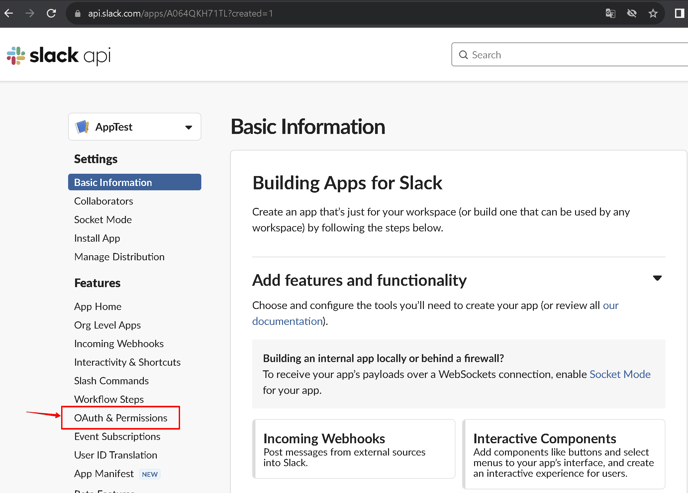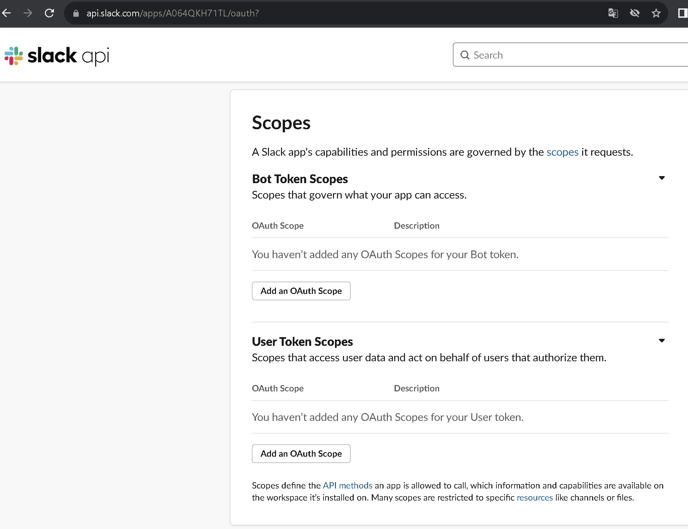Event Tracking Type: Send Slack Message
The “Send Slack Message” tracking type automatically sends Slack messages to a particular user or channel when a certain event takes place, ensuring timely alerts.
Read more about the Event Tracking feature and its configuration in the “Event Tracking (LMS / Call Logic)” Knowledge Base article.
To configure the “Send Slack Message” tracking rule, follow these two main steps. First, set up the necessary settings in your Slack App. Then, complete the configuration in the system.
Slack App Settings
To configure the Slack App settings, follow this link https://api.slack.com/apps and log in with your email.
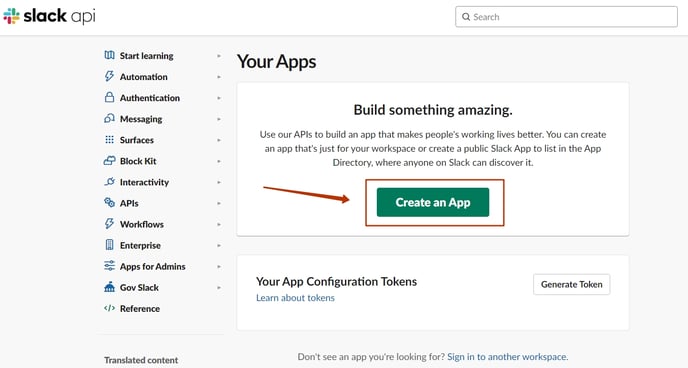 Click the “Create an App” button and select the “From Scratch” option.
Click the “Create an App” button and select the “From Scratch” option.
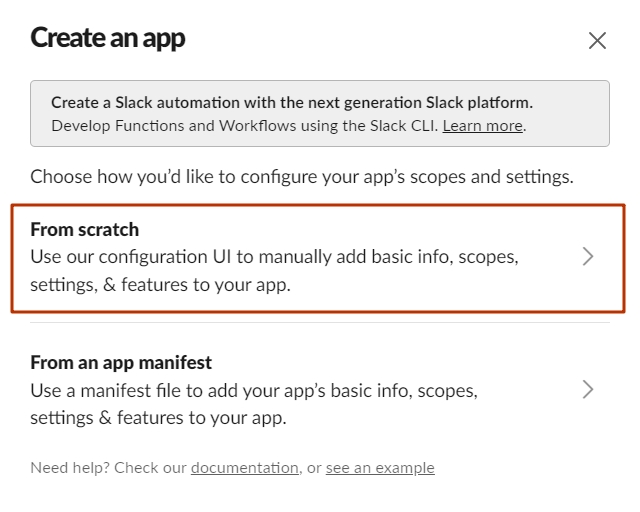 Enter the Slack App name and select the workspace. Click the “Create App” button.
Enter the Slack App name and select the workspace. Click the “Create App” button.
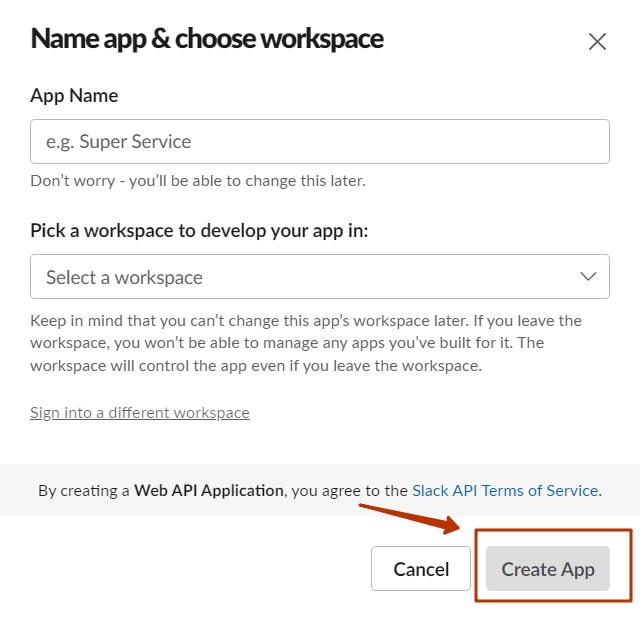 After creating the app, you will be redirected to the App Settings, specifically to the Basic Information section. Go to the “OAuth & Permissions” section.
After creating the app, you will be redirected to the App Settings, specifically to the Basic Information section. Go to the “OAuth & Permissions” section.
In the "OAuth & Permissions" section, choose the "Scopes" block, then select one of the following message-sending types by adding an OAuth Scope with the necessary permissions:
- Bot Token Scopes: This type allows you to set up sending messages from the bot.
- User Token Scopes: This type allows you to set up sending messages from the Slack Admin.
The main necessary permissions are:
- channels:join - Join public channels in a workspace.
- chat:write - Send messages as @AppName.
- chat:write.public - Send messages to channels @AppName isn't a member of.
- im:write - Start direct messages with people.
After adding an OAuth Scope, in the same section, go back to the "OAuth Tokens for Your Workspace" block and click the “Install to Workspace” button to configure the automatic token generation to finish connecting the app to your workspace.
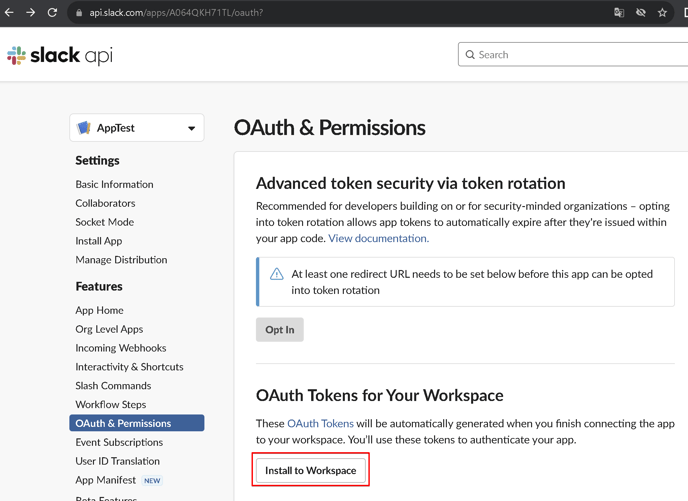 Click the “Allow” button to complete the setting process.
Click the “Allow” button to complete the setting process.
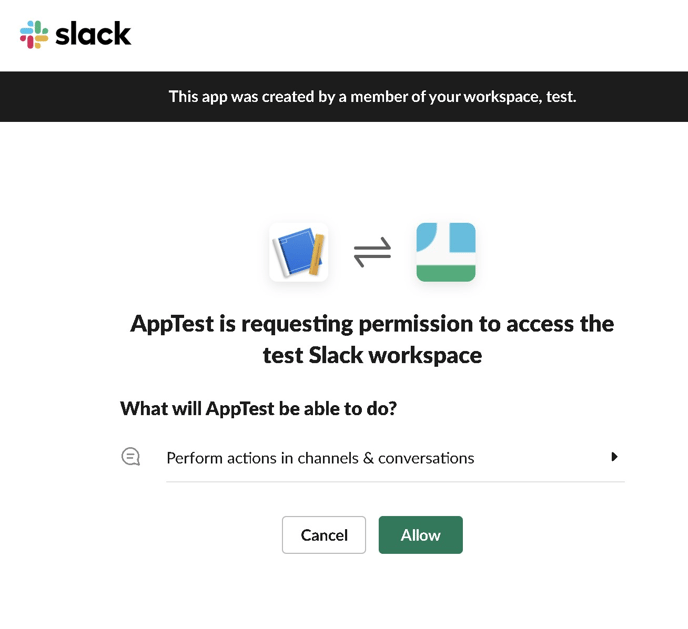 After allowing the requested permissions, the User and/or Bot User OAuth Tokens will be generated, which need to be used to set up the tracing rule in the system, and the app will be added to your Slack workspace under the Apps block at the bottom.
After allowing the requested permissions, the User and/or Bot User OAuth Tokens will be generated, which need to be used to set up the tracing rule in the system, and the app will be added to your Slack workspace under the Apps block at the bottom.
System Settings
The “Send Slack Message” tracking rule can be configured on the Product, Campaign, and Publisher levels.
To create this tracking rule, navigate to the corresponding level, access the Tracking tab, and fill in the following fields in the “Add Rule” pop-up window:
- Trigger: Select the event that triggers the action:
- [LMS] Lead Sold: The lead is sold through the Campaign.
- [LMS] Lead Redirect: The lead is redirected to the specified URL.
- [LMS] Lead Rejected: The lead is not accepted by any Campaign.
- [LMS] Campaign Rejected: The Campaign has rejected the lead.
- [LMS] Publisher Earning Received: The Publisher has received earnings.
- [LMS] Campaign Sold: The lead was sold to the Сampaign.
- [LMS] Revenue Ping Back: The revenue pingback has been sent.
- [LMS] Revenue Postback: The revenue postback has been sent.
- [LMS] Lead Offer Received: The lead status changed to "Offer Received" after a successful ping (for Ping Post Products only).
- [LMS] Disposition Updated: Buyer Disposition has been updated.
- [LMS] Publisher Earning Adjusted: Lead Adjustment happened.
- [LMS] Lead Return: Lead Return happened.
- [LMS] Lead Partial Return: Lead Partial Return happened.
- [LMS] Price Reject Sold: The lead price reject sold.
- [LMS] Price Reject Rejected: The lead price reject rejected.
- [LMS] Price Reject Register: The lead price reject registered.
- [Call Logic] Lead Sold: The lead was sold to the Publisher.
- [Call Logic] Lead Rejected: The lead was rejected by the Publisher.
- [Call Logic] Campaign Rejected: The Campaign has rejected the lead.
- [Call Logic] Campaign Accepted: The Campaign has accepted the lead.
- [Call Logic] Campaign Sold: The lead was sold to the Campaign.
- [Call Logic] Call Recorded: The call is recorded and is ready to be downloaded.
- [Call Logic] Publisher Earning Received: Fires every time the Publisher gets earning (Direct Sold / Revenue Post-back).
- [Call Logic] Buyer Response: The Buyer has answered the call.
- [Call Logic] Disposition Updated: Buyer Disposition has been updated.
- [Call Logic] Publisher Earning Adjusted: Lead Adjustment happened.
- [Call Logic] Lead Return: Lead Return happened.
- [Call Logic] Lead Partial Return: Lead Partial Return happened.
- [Call Logic] Duration To Sell Reached: Lead has reached the "Duration to sell" time.
- [Call Logic] AMD: Answering machine detected on the buyer's side.
- [Call Logic] Revenue Postback: Revenue Postback sent.
- Action: Select the “[TPS] Send Slack Message” option.
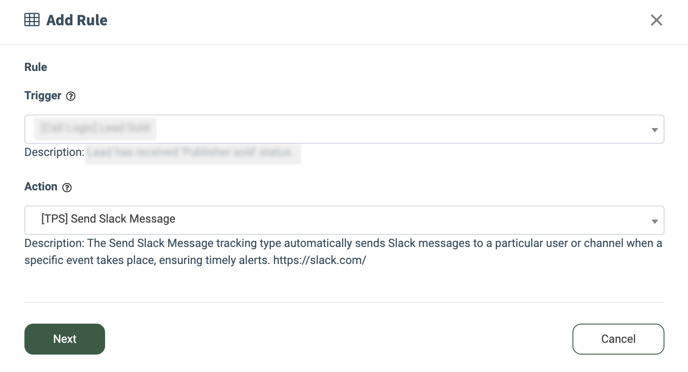
Once you select the preferable event, click the “Next” button to proceed with the setup.
The “Trigger Settings” block allows you to set up additional filters for the selected event. The filter fields are optional. If no filters are set up, the action will be triggered for all the leads that fit the event trigger.
Depending on the user role, platform, and configuration level, the following filters for trigger settings are available:
- Method: Select the Method (POST/FORM).
- Publisher: Select the Publisher.
- Publisher Exclude: Select the Publisher to exclude from the rule.
- Channel: Select the Channel.
- Channel Exclude: Select the Publisher Channel to exclude from the rule.
- Call Tracking Pool: Select the call tracking pool (available only for Call Logic triggers).
- Source: Select the Source.
- Source Exclude: Select the Source to exclude from the rule.
- Buyer: Select the Buyer.
- Campaign: Select the Campaign.
- Pingtree: Select the Pingtree.
- Price Restrictions: Select the Price restrictions (Price is greater than 0, Price is greater than a certain value, Price is greater than or equal to a certain value, Price is lower than a certain value, Price is lower than or equal to a certain value, Price range inclusive). Note: The “Price range inclusive” value is available only for the “Lead Sold” and “Campaign Sold” triggers.
- Price Restriction Value: Enter the price value.
- Min Price: Enter the minimum price value to trigger the rule by the price range (available only for the “Price range inclusive” value in the “Price Restrictions” field).
- Max Price: Enter the maximum price value to trigger the rule by the price range (available only for the “Price range inclusive” value in the “Price Restrictions” field).
-1.png?width=688&height=967&name=unnamed%20(67)-1.png)
The “Action Settings / [TPS] Send Slack Message” block allows you to configure the action required for the rule setup:
- Auth Token: Enter the authentication token for your Slack workspace from your Slack App. The token (either User's or Bot's) can be found in the OAuth & Permissions > OAuth Tokens for Your Workspace section in the Slack App.
- Action: Select the action you want to perform - send a message to the user (the “Send direct message” option) or the channel (the “Send message to channel” option).
- If the “Send direct message” option is selected:
- Slack Member ID: Enter the recipient’s Slack Member ID for the message.
- If the “Send message to channel” option is selected:
- Slack Channel ID: Enter the Slack Channel ID where the message should be sent.
- If the “Send direct message” option is selected:
- Message Text: Enter the text of the Slack message. You can add placeholders as well. To view them, click the “Show available placeholders” button.
Click the “Save Rule” button to confirm.
Read more about Tracking Rule setting up on the Product level in this Knowledge Base article.
Read more about Tracking Rule setting up on the Campaign level in this Knowledge Base article.
Read more about Tracking Rule setting up on the Publisher level in this Knowledge Base article.
Read more about Notification tracking in this Knowledge Base article.
